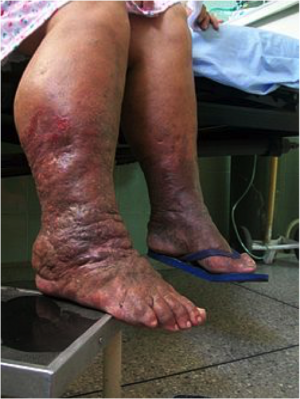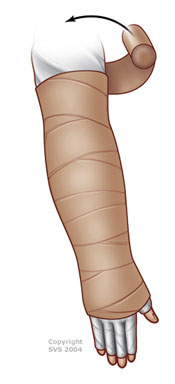Manual Lymphatic Drainage
This article is currently under review and may not be up to date. Please come back soon to see the finished work! (30/07/2020)
Description[edit | edit source]
Lymphatic massage, also called lymphatic drainage or manual lymph drainage, is a technique developed in Germany for treatment of lymphedema, an accumulation of fluid that can occur after lymph nodes are removed during surgery.
- Lymphedema can be present at birth or develop at puberty or during adulthood. This type, known as primary lymphedema, can affect as many as four limbs and/or other parts of the body.
- Lymphatic drainage massage for conditions other than lymphedema is not medically recommended, although it may be promoted by some therapists.
- Manual Lymphatic Drainage [MLD] is an unique, gentle type of skin massage technique that promotes lymph to drain out of a limb into an area that drains normally. It is mainly used for lymphoedema.
- In addition to improving lymphatic circulation, MLD also increases blood flow in deep and superficial veins.[1]
Techniques[edit | edit source]
There are a various techniques for MLD including the Vodder, Földi, Leduc or Casley-Smith methods. The most appropriate techniques, optimal frequency and indications for MLD, as well as the benefits of treatment, all remain to be clarified, but the different methods have several aspects in common [2], as:
- Usually performed with the patient in the lying position, unless for lymphoedema of the head and neck
- Starts and ends with deep diaphragmatic breathing
- The unaffected lymph nodes and region of the body are treated first
- Moves proximal to distal to drain the affected areas
- Slow and rhythmical movements
- Uses gentle pressure
Different Approaches
1. Vodder - Different kinds of hand motions are used on the body depending on the part being treated. It also includes treatment of fibrosis
2. Foldi - Based on the Vodder technique, this method lays emphasis on thrust and releaxation. It helps in management of edema through 'encircling strokes'.
3. Casley-Smith - This method involves use of small and gentle effleurage movements with the side of the hand.
4. Leduc - It involves use of special 'call up' (or enticing) and 'reabsorption' movements which reflet how lymph is absorbed first in the initial lymphatics and then into larger lymphatics.[3]
Indications[edit | edit source]
- Primary or secondary lymphedema
- Lipedema
- Phlebo-lymphostatic edema
- Postoperative edema
- Posttraumatic edema [4]
- Chronic venous insufficiency [1]
- Palliative care: Provision of comfort and pain relief when other physical therapies are no longer appropriate [2]
- This technique may be used as a complement in therapies for patients with stress. [5]
- May be effective for reducing intracranial pressure in severe cerebral diseases.[6]
Contraindications[edit | edit source]
Absolute Contraindication:
- Decompensated cardiac insufficiency
- Cardiac edema
- Congestive heart failure
- Acute inflammation caused by pathogenic germs (bacteria, fungi, viruses). The germs could be spread by the manual lymph drainage, with resulting blood poisoning (sepsis).
- Acute renal failure
Condition stated above must not be treated with manual lymph drainage.
Relative Contraindication:
- Malignant lymphedema caused by active cancer[7]
Principles[edit | edit source]
- The skin is stretched in specific directions using hand movements to promote variations in interstitial pressure without the use of oils.
- Slow repetitive movements are used which incorporate a resting phase allowing skin to return to its normal position.
- The pressure is varied according to the underlying tissue with the aim to promote lymphatic drainage.
- Areas of fibrosis are treated using deeper and firmer movements in combination with Compression therapy.
- The lymphatic drainage strats centrally and proximally with treatments usually starting around the neck.
- Functional and healthy lymph nodes are treated first, followed by proximal and contralateral areas and then ipsilateral and lymphoedematus areas.
- There is emphasis on treatment of anterior and posterior trunk in the early phases before the swollen limb is treated.
- Breathing techniques used are combined with pressure by the therapist's hands which promotes drainage of deep abdominal lymph nodes.
- Limb mobilization and relaxation techniques are often combined with lymphatic drainage.[3]
Techniques - to use in conjunction[edit | edit source]
In addition to lymphatic massage, patients may be advised to do
- Self-massage following instructions from their therapists
- Special light exercises designed to encourage the flow of lymphatic fluid out of the affected limb.
- Wear compression garments such as long sleeves or stockings designed to compress the arm or leg and encourage lymphatic flow out of the limb[8].
Resources[edit | edit source]
see videos on this page reagarding techniques on Lymphodema management
References[edit | edit source]
- ↑ 1.0 1.1 Crisóstomo RS, Candeias MS, Armada-da-Silva PA. Venous flow during manual lymphatic drainage applied to different regions of the lower extremity in people with and without chronic venous insufficiency: a cross-sectional study.Physiotherapy. 2016 Feb 1. pii: S0031-9406(16)00023-7.
- ↑ 2.0 2.1 Lymphoedema Framework. Best Practice for the Management of Lymphoedema. International consensus. London: MEP Ltd, 2006.
- ↑ 3.0 3.1 Williams AF. Manual lymphatic drainage: Exploring the history and evidence base. British Journal of Community Nursing. 2010;15(4):S18-24. DOI: 10.12968/bjcn.2010.15.Sup3.47365
- ↑ Michael Földi, Roman Strößenreuther. (2003). Basic Principles of Manual Lymph Drainage. In R. S. Michael Földi, FOUNDATIONS OF MANUAL LYMPH DRAINAGE, 3rd ed (pp. 48-49). St. Louis Missouri: Elsevier Mosby.
- ↑ Jung-Myo S, Sung-Joong K. Manual Lymph Drainage Attenuates Frontal EEG Asymmetry in Subjects with Psychological Stress: A Preliminary Study. J Phys Ther Sci. 2014 Apr; 26(4): 529–531.
- ↑ Roth C, Stitz H, Roth C, Ferbert A, Deinsberger W, Pahl R et. al. Craniocervical manual lymphatic drainage and its impact on intracranial pressure - a pilot study. Eur J Neurol. 2016 Sep;23(9):1441-6.
- ↑ Moffatt C, Doherty D, Morgan P. Lymphoedema framework. Best Practice for Management of Lymphoedema. International Consensus. London: MEP Limited;2006.58
- ↑ WEIL MLD Available from:https://www.drweil.com/health-wellness/balanced-living/wellness-therapies/lymphatic-massage-therapy/ (last accessed 28.7.2020)








